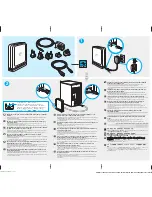
NOTE:
You can also use the QoS cell mode application with QoS parameters to
manage the integration of HRR and SAR schedulers.
Specifying the QoS cell mode application with the
qos-parameter-define
command
enables you to configure a port with either frame or cell shaping mode and then
configure the port for low-CDV port mode.
Related Topics
For more information about scheduler profiles, see Scheduler Hierarchy Overview
on page 45
■
■
For more information about configuring QoS profiles, see QoS Profile Overview
on page 127
■
For more information about configuring QoS parameters, see QoS Parameter
Overview on page 225
Per-Packet Queuing on the SAR Scheduler Overview
You can configure port queuing on the SAR scheduler, enabling per-packet rather
than per-circuit scheduling. Port queuing mode allows you to use more of the facilities
of the HRR scheduler, which are effectively disabled in default integrated mode,
while at the same time making the SAR scheduler more transparent. In port queuing
mode, you use the QoS application to configure the three levels of the HRR scheduler,
including weighted round robin, traffic shaping, and strict priority scheduling.
You can configure the following modes:
■
Default integrated mode—The ATM SAR scheduler does the scheduling. Both VC
and port backpressure are enabled, and the HRR scheduler does minimal
scheduling. The SAR scheduler performs significant buffering.
■
Low-latency mode—The HRR scheduler does the scheduling. All QoS
configurations are supported. VC backpressure is disabled, port backpressure is
set as aggressive, and the SAR scheduler does minimal buffering. This mode
enables the lowest latency for packets scheduled in the HRR scheduler with strict
priority. Because the SAR scheduler is running with minimal buffering, there is
no head-of-line blocking.
■
Low-CDV mode—The HRR and SAR schedulers both perform scheduling; QoS
synchronizes the rates of the two schedulers. All QoS configurations are
supported. VC backpressure is disabled, and port backpressure is set to the
default thresholds of 6 MB per OC3 port and 24 MB per OC12 port. In this mode,
you can configure shaping in both the SAR scheduler and the HRR scheduler;
low-cdv mode works with cell shaping mode only and enables relative weighted
VCs and hierarchical shaping in the HRR scheduler. The SAR scheduler performs
normal buffering and can shape either the VC or VP, but not both.
Per-Packet Queuing on the SAR Scheduler Overview
■
163
Chapter 19: Configuring an Integrated Scheduler to Provide QoS for ATM
Summary of Contents for JUNOSE 11.1.X - QUALITY OF SERVICE CONFIGURATION GUIDE 3-21-2010
Page 6: ...vi...
Page 24: ...xxiv List of Figures JUNOSe 11 1 x Quality of Service Configuration Guide...
Page 28: ...xxviii List of Tables JUNOSe 11 1 x Quality of Service Configuration Guide...
Page 34: ...2 QoS on the E Series Router JUNOSe 11 1 x Quality of Service Configuration Guide...
Page 76: ...44 Scheduling and Shaping Traffic JUNOSe 11 1 x Quality of Service Configuration Guide...
Page 156: ...124 Monitoring QoS Scheduling and Shaping JUNOSe 11 1 x Quality of Service Configuration Guide...
Page 190: ...158 Interface Solutions for QoS JUNOSe 11 1 x Quality of Service Configuration Guide...
Page 344: ...312 Monitoring and Troubleshooting QoS JUNOSe 11 1 x Quality of Service Configuration Guide...
Page 388: ...356 Monitoring QoS Parameter Definitions JUNOSe 11 1 x Quality of Service Configuration Guide...
Page 391: ...Part 8 Index Index on page 361 Index 359...
Page 392: ...360 Index JUNOSe 11 1 x Quality of Service Configuration Guide...
















































